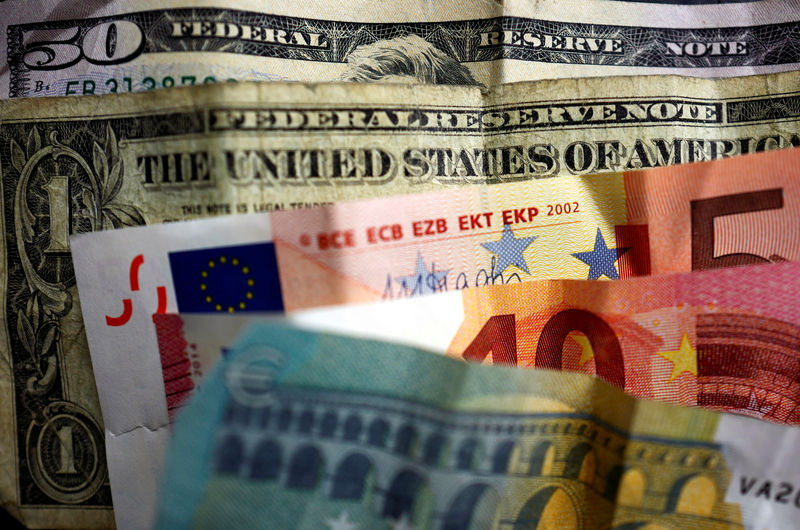Here is what you need to know on Tuesday, October 29:
Financial markets seem to have adopted a cautious tone following Monday’s choppy action. The US economic calendar will feature Goods Trade Balance and JOLTS Job Openings data for September, alongside the Conference Board’s Consumer Confidence Index for October.
Investors refrain from taking large positions while gearing up for key risk events. Later in the week, third-quarter Gross Domestic Product (GDP) data, Personal Consumption Expenditures (PCE) Price Index figures for September and October employment report from the US will be scrutinized by market participants, who will also keep a close eye on key earnings reports heading into the US presidential election. After closing the first trading day of the week virtually unchanged, the US Dollar (USD) Index continues to move sideways above 104.00. Meanwhile, US stock index futures trade mixed in the early European session.
US Dollar PRICE Last 7 days
The table below shows the percentage change of US Dollar (USD) against listed major currencies last 7 days. US Dollar was the strongest against the Japanese Yen.
| USD | EUR | GBP | JPY | CAD | AUD | NZD | CHF | |
|---|---|---|---|---|---|---|---|---|
| USD | 0.04% | 0.12% | 1.45% | 0.42% | 1.34% | 0.88% | -0.07% | |
| EUR | -0.04% | 0.08% | 1.44% | 0.37% | 1.28% | 0.85% | -0.11% | |
| GBP | -0.12% | -0.08% | 1.35% | 0.30% | 1.20% | 0.76% | -0.19% | |
| JPY | -1.45% | -1.44% | -1.35% | -1.03% | -0.13% | -0.59% | -1.52% | |
| CAD | -0.42% | -0.37% | -0.30% | 1.03% | 0.92% | 0.46% | -0.49% | |
| AUD | -1.34% | -1.28% | -1.20% | 0.13% | -0.92% | -0.45% | -1.40% | |
| NZD | -0.88% | -0.85% | -0.76% | 0.59% | -0.46% | 0.45% | -0.94% | |
| CHF | 0.07% | 0.11% | 0.19% | 1.52% | 0.49% | 1.40% | 0.94% |
The heat map shows percentage changes of major currencies against each other. The base currency is picked from the left column, while the quote currency is picked from the top row. For example, if you pick the US Dollar from the left column and move along the horizontal line to the Japanese Yen, the percentage change displayed in the box will represent USD (base)/JPY (quote).
USD/JPY started the week with a bullish gap as markets reacted to political developments in Japan. After reaching its highest level since late July near 154.00 in the Asian trading hours on Monday, the pair staged a downward correction and closed the day near 153.30. Early Tuesday, USD/JPY continues to edge lower and trades slightly below 153.00. Japan’s Finance Minister Katsunobu Kato said on Tuesday that he is closely watching the moves in foreign exchange markets with a higher sense of vigilance, including those driven by speculators. In the meantime, the data from Japan showed that the Unemployment Rate declined to 2.4% in September from 2.5%.
EUR/USD closed marginally higher on Monday and seems to have entered a consolidation phase slightly above 1.0800 on Tuesday. The European Central Bank (ECB) Vice President Luis de Guindos said on Monday that the central bank has made significant progress in bringing down inflation but added that they can’t declare victory just yet.
GBP/USD failed to gather directional momentum and ended the first day of the week flat. The pair extends its sideways grind above 1.2950 in the European morning. The Bank of England (BoE) will release Consumer Credit data for September later in the session.
AUD/USD posted daily losses on Monday and extended its slide early Tuesday. In the Asian session on Wednesday, third-quarter Consumer Price Index (CPI) data from Australia will be watched closely by investors. At the time of press, the pair was down 0.2% at 0.6570.
Gold benefited from the souring risk mood and registered small gains on Monday. XAU/USD holds its ground early Tuesday and trades within a touching distance of the all-time high it set at $2,758 last Wednesday.
Risk sentiment FAQs
In the world of financial jargon the two widely used terms “risk-on” and “risk off” refer to the level of risk that investors are willing to stomach during the period referenced. In a “risk-on” market, investors are optimistic about the future and more willing to buy risky assets. In a “risk-off” market investors start to ‘play it safe’ because they are worried about the future, and therefore buy less risky assets that are more certain of bringing a return, even if it is relatively modest.
Typically, during periods of “risk-on”, stock markets will rise, most commodities – except Gold – will also gain in value, since they benefit from a positive growth outlook. The currencies of nations that are heavy commodity exporters strengthen because of increased demand, and Cryptocurrencies rise. In a “risk-off” market, Bonds go up – especially major government Bonds – Gold shines, and safe-haven currencies such as the Japanese Yen, Swiss Franc and US Dollar all benefit.
The Australian Dollar (AUD), the Canadian Dollar (CAD), the New Zealand Dollar (NZD) and minor FX like the Ruble (RUB) and the South African Rand (ZAR), all tend to rise in markets that are “risk-on”. This is because the economies of these currencies are heavily reliant on commodity exports for growth, and commodities tend to rise in price during risk-on periods. This is because investors foresee greater demand for raw materials in the future due to heightened economic activity.
The major currencies that tend to rise during periods of “risk-off” are the US Dollar (USD), the Japanese Yen (JPY) and the Swiss Franc (CHF). The US Dollar, because it is the world’s reserve currency, and because in times of crisis investors buy US government debt, which is seen as safe because the largest economy in the world is unlikely to default. The Yen, from increased demand for Japanese government bonds, because a high proportion are held by domestic investors who are unlikely to dump them – even in a crisis. The Swiss Franc, because strict Swiss banking laws offer investors enhanced capital protection.













